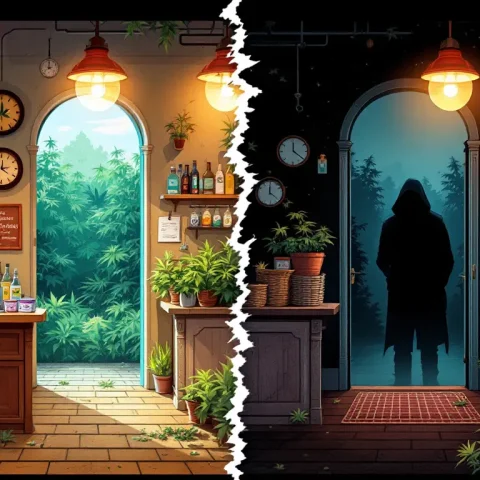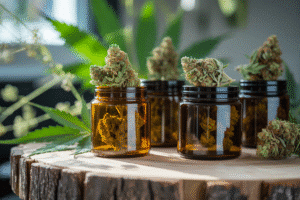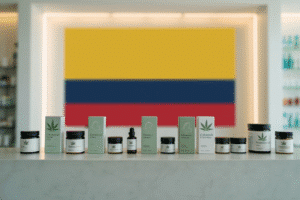- Progress & Challenges
Dutch Cannabis Experiment: Navigating Supply Chain Issues

Contents
Contents
Europe’s Most Ambitious Cannabis Reform
The clock is ticking for Amsterdam’s legendary cannabis scene. By April 2025 – just months away – every gram of cannabis sold in participating Dutch coffee shops must come from licensed cultivators, marking the end of the Netherlands’ decades-old “tolerated” supply system. This isn’t a gradual shift; it’s a hard deadline that’s sending shockwaves through Europe’s most famous cannabis market.
Picture walking into an Amsterdam coffee shop after this watershed moment. Instead of sourcing cannabis through the infamous “backdoor policy,” every product on the menu will require quality certifications and transparent supply chain tracking. Currently, shops in the pilot program can still sell a mix of regulated and ‘tolerated’ cannabis products – but that grace period is rapidly coming to an end.
The Netherlands, long synonymous with progressive cannabis policies, stands at a crossroads. Despite the country’s famous coffee shops operating openly for decades, the supply chain feeding these establishments has remained stubbornly illegal. Now, through this carefully planned experiment, Dutch authorities aim to create Europe’s first fully regulated, closed-loop cannabis market.
But here’s the catch: the path to regulation isn’t as smooth as anyone hoped. With licensed cultivators struggling to meet production targets and hash production presenting unexpected challenges, the experiment faces critical delays that could reshape its timeline and impact. This deep dive explores the complexities, challenges, and potential solutions emerging from this pioneering initiative – and why its success or failure could reshape cannabis policy across Europe.
Understanding the “Backdoor Policy” and Why Change is Crucial
The Netherlands’ famous “gedoog” policy – where cannabis sales are tolerated but not technically legal – has created a paradox that’s haunted the country’s coffee shops for decades. These establishments can legally sell cannabis to consumers, yet their supply chain exists in a legal grey area that’s increasingly difficult to justify.
Think about it: coffee shop owners must somehow magically acquire their stock without anyone acknowledging where it came from. This backdoor approach has inadvertently fueled black market operations and created quality control challenges that modern cannabis markets can’t afford to ignore.
The need for change became impossible to ignore as other countries began establishing regulated cannabis markets. The Netherlands risked falling behind despite its pioneering history. The Dutch cannabis experiment emerged as an ambitious solution – a chance to transform an unregulated supply chain into a transparent, quality-controlled system.
The Experiment’s Timeline: Racing Against the Clock
The Dutch cannabis experiment isn’t just another policy shift – it’s a carefully orchestrated transition with hard deadlines and high stakes. Following similar approaches to Switzerland’s cannabis pilot programs, the Netherlands has structured its experiment in clear phases:
| Phase | Timeline | Key Changes | Status |
|---|---|---|---|
| Initial Launch | 2023-2024 | Test phase begins Mixed stock allowed First licensed cultivators start | Completed |
| Current Phase | 2024-Early 2025 | Production scaling up Supply chain testing Quality control refinement | In Progress |
| Final Transition | April 2025 | 100% regulated stock only Full transparency required Complete supply tracking | Upcoming |
The transition hasn’t been smooth sailing. Production delays and technical hurdles have already forced timeline adjustments. Yet Dutch authorities remain committed to the April 2025 deadline, creating mounting pressure on every link in the supply chain. Coffee shops must now race against time to ensure their supply chains are fully compliant before the final transition kicks in.
Supply Chain Challenges: The Production Puzzle
Licensed cultivators face a mountain of challenges in meeting the Dutch market’s demanding requirements. As high-quality cannabis strains become increasingly important to consumers, producers must balance quantity with quality under strict regulatory oversight.
Here’s what cultivators need to deliver:
| Requirement Type | Target | Current Challenge |
|---|---|---|
| Monthly Production | 6,500 kg | Production capacity falling short |
| Product Varieties | Min. 10 strains | Limited genetic diversity |
| Hash Production | 1,500 kg/month | Technical difficulties |
| Quality Standards | EU-GMP | Certification delays |
| Testing Requirements | Weekly batch testing | Laboratory bottlenecks |
The hash production challenge particularly stands out. Traditional hash-making methods don’t easily scale to industrial levels while maintaining quality. Several licensed producers have reported significant technical hurdles in developing consistent, high-quality hash products that meet regulatory standards.
Expert Insight:
“We’re not just scaling up production – we’re reinventing how cannabis is produced at a commercial scale under strict regulatory requirements,” explains Orville Bovenschen of Leli Holland. The remaining cultivators now face a 9-month deadline to prove they can meet these demanding targets.
Consumer Experience: Quality Meets Regulation
The success of the Dutch experiment hinges on one crucial factor: consumer satisfaction. With boutique cannabis strains setting new standards for quality and variety, the regulated market must meet – or exceed – current consumer expectations.
Here’s how the new system impacts the coffee shop experience:
| Aspect | Current System | New Regulated System |
|---|---|---|
| Product Selection | Wide variety, inconsistent quality | Standardized options, verified quality |
| Price Points | Market-driven, variable | Regulated, potentially higher |
| Quality Control | Limited oversight | Full lab testing |
| Product Information | Often limited or unreliable | Detailed certificates and labeling |
| Hash Availability | Multiple varieties and sources | Limited options initially |
Consumer Concerns:
- Price increases due to regulatory compliance costs
- Reduced product variety during initial transition
- Changes to familiar strains and hash products
- Adaptation to new quality standards
Yet early feedback from pilot locations shows promising signs. Where regulated products are available, consumers report increased confidence in product safety and consistency. Coffee shop owners note that while some customers initially resist change, many appreciate the detailed product information and quality guarantees now available.
Political and Regulatory Framework: Navigating Complex Waters
The Dutch cannabis experiment hasn’t just stirred debate in coffee shops – it’s sparked intense political discussion. Despite attempts to halt the program, parliamentary support remains strong, reflecting broader European trends toward cannabis industry modernization.
Key Regulatory Requirements for Licensed Operators:
| Category | Requirements | Oversight Body |
|---|---|---|
| Cultivation | EU-GMP certification Environmental controls Security systems | Ministry of Health |
| Testing | Weekly batch analysis Potency verification Contaminant screening | Independent Labs |
| Distribution | Track-and-trace system Secure transport Chain of custody | Cannabis Agency |
| Retail | Product verification Staff training Sales limits | Local Authorities |
A recent vote against halting the experiment demonstrated strong political will to move forward, even as the new coalition government grapples with implementation challenges. The regulatory framework emphasizes three core principles:
- Quality Assurance: Strict production standards and regular testing
- Supply Chain Control: Complete traceability from seed to sale
- Consumer Protection: Clear labeling and verified product information
The framework represents one of Europe’s most comprehensive attempts to regulate cannabis, serving as a potential model for other nations considering similar reforms.
Lessons Learned and Future Outlook: A Model for Europe?
As April 2025 approaches, the Dutch cannabis experiment offers valuable insights for markets worldwide. Drawing parallels with medical cannabis developments, several key lessons emerge:
| Lesson | Impact | Future Implications |
|---|---|---|
| Supply Chain Complexity | Production delays, quality challenges | Need for gradual scaling |
| Consumer Adaptation | Initial resistance, growing acceptance | Focus on education and transparency |
| Regulatory Balance | Strict oversight vs. market viability | Flexible framework development |
| Market Evolution | From grey market to regulated industry | Professional standards emergence |
Looking Ahead: 2025 and Beyond
- Full implementation across participating municipalities
- Four-year evaluation period begins
- Potential expansion to additional regions
- Model refinement based on real-world data
The experiment’s success could catalyze similar reforms across Europe. Regulators, cultivators, and coffee shop owners face intense months ahead, but the potential reward is significant: a sustainable, transparent, and legal cannabis market that preserves the Netherlands’ cannabis culture while ensuring product safety and quality.
Frequently Asked Questions About the Dutch Cannabis Experiment
1. Will coffee shops close during the transition?
No, coffee shops in participating municipalities will remain open throughout the transition. However, by April 2025, they must switch entirely to regulated cannabis products. Some shops may experience temporary supply limitations as producers scale up to meet demand.
2. How will prices change under the new system?
Initial projections suggest modest price increases due to regulatory compliance costs and quality control measures. However, competition between licensed producers is expected to help stabilize prices over time. The exact pricing will vary by product and location.
3. What happens to existing coffee shops not in participating municipalities?
Coffee shops outside the participating municipalities will continue operating under the current “tolerated” system. The experiment’s success will likely determine whether the new regulations expand nationwide.
4. Can tourists still visit coffee shops?
Yes, the experiment doesn’t change tourist access to coffee shops. However, visitors should expect to see changes in product selection and may notice new labeling and quality certification information on products.
5. What products will be available under the new system?
Licensed producers must offer a minimum of 10 different cannabis strains and several hash varieties. While initial selection may be limited compared to the current market, all products will be lab-tested and quality-certified.
6. How is product quality controlled?
All cannabis products must undergo regular laboratory testing for:
- Potency (THC/CBD levels)
- Contaminants (pesticides, heavy metals)
- Microbiological safety
- Terpene profiles
7. What happens if licensed producers can’t meet demand?
The government has contingency plans for supply shortages, including possible deadline extensions for specific products. However, the April 2025 transition deadline remains firm for participating coffee shops.
8. How can businesses prepare for these changes?
Coffee shops and suppliers should:
- Begin transitioning to regulated suppliers early
- Train staff on new compliance requirements
- Update inventory systems for track-and-trace
- Communicate changes clearly to customers
Take Action
Stay informed about these historic changes:
- Follow our blog for regular updates on cannabis regulations
- Subscribe to our newsletter for industry insights
- Visit our store to explore our current selection of legal cannabis products
- Join the conversation – share your thoughts on the Dutch experiment in the comments below
The Dutch cannabis experiment isn’t just about changing laws – it’s about creating a blueprint for responsible cannabis regulation in the 21st century. As April 2025 approaches, all eyes are on the Netherlands to see if this ambitious experiment will deliver on its promises.
Disclaimer: This article is provided for informational purposes only and reflects the Dutch cannabis experiment’s status as of February 2025. Regulations and implementation timelines may change. While we strive to maintain accurate and up-to-date information, readers should verify current regulations with official sources before making any decisions. This content is not intended as legal advice. Cannabis laws vary by jurisdiction – always comply with your local regulations.




